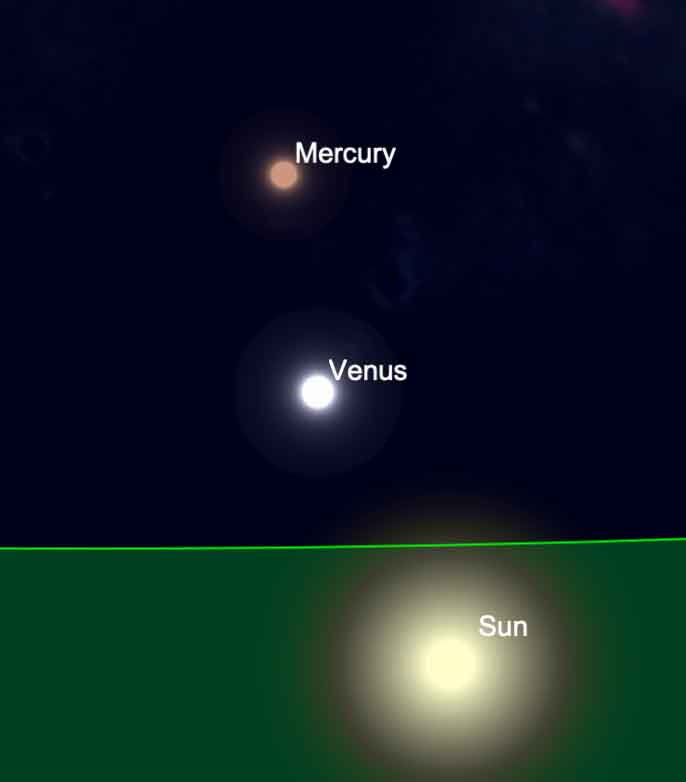Sky Report: May 3 – May 9

This week and the next two all five naked eye planets are visible at one time or another, beginning with Venus and Mercury.
Both are very low in the west-northwest at sunset, and the trick is that 1) you need to look immediately after sunset, 2) you need a flat, low horizon, and 3) binoculars are important. Venus is especially bright but it’s only 11° from the sun (the width of your fist held at arm’s length) while Mercury is twice as far from the sun but is only 1/20th as bright. Mercury is straight above Venus and the separation between them increases noticeably day by day this week.
Next week the moon joins them briefly.
Venus becomes easier to see night-by-night through the summer, but Mercury remains visible only until the last week of May.
The very bright star well to the left of these planets is Sirius, the Dog Star”, best seen in winter.
Mars is a third of the way up the west as darkness falls, in the feet of the Gemini twins, below the stars Castor and Pollux and above Betelgeuse in Orion. It’s only as bright as the brighter stars that surround it, so it doesn’t stand out like it did late last year.
Finally, Jupiter and Saturn rise together at the end of the night, and the best time to see them is 60-90 minutes before sunrise, when they’re both low in the southeast. Jupiter is brighter than any star while Saturn is 1/13th as bright as Jupiter, and is 16° to the upper right of Jupiter. Saturn is a few degrees to the upper left of the moon on the morning of the 3rd and Jupiter is 8° from the moon on the following two mornings.
While checking out Jupiter and Saturn notice that the summer Milky Way extends from the south, passes overhead, and continues to the north, arcing overhead near the bright star Vega. The annual Eta Aquarid meteor Shower peaks on the morning of May 7th but meteors are visible for a week surrounding that date. These fast meteors travel at 41 miles/second, and they come from dust shed by Halley’s Comet long ago. An observer in a dark location may see one meteor every few minutes, so it’s not spectacular. They radiate from the southeast horizon but appear all over the sky. Look after midnight.
The Sky Report is presented as a public service by the Stellar Vista Observatory, a nonprofit organization based in Kanab, Utah, which provides opportunities for people to observe, appreciate, and comprehend our starry night sky. Additional information is at www.stellarvistaobservatory.org. Send questions and comments to
John@StargazingAdventures.org.






Comments are closed.